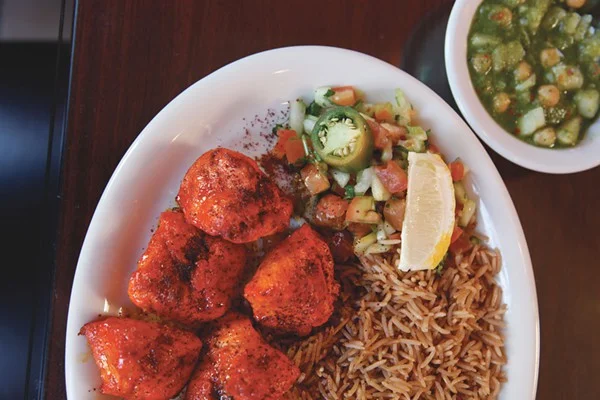Burani Katchalu in a whole wheat pita pocket
By Humaira
Today I have fabulous vegetarian Afghan recipe from Turmeric, The Wonder Spice an e-cookbook.
I served this dish in pita pockets, lathered with the creamy yogurt sauce from the recipes and a freshly tossed salad.
FreshSalad
Fresh veggies and garbanzo beans
Here is how authors – Helen Saberi and Colleen Taylor Sin recommend you make this dish.
Afghan Potatoes with Spicy Yogurt Sauce
Burani Katchalu
In Afghanistan, this dish is called Burani Katchalu. Burani is the name given to a vast range of dishes across the Islamic heartland, from Spain to the Balkans and from Morocco to India. Burani can be made with any variety of vegetable, including eggplant, potatoes, and spinach, but no matter the main ingredient, it always has a yogurt sauce.
There are many legends about this dish’s origin; one is that Burani was the nickname of the princess who married the Caliph of Baghdad in the 9th century, and burani the food has evolved from a special yogurt dish served at her lavish wedding celebrations. Whatever the true origin, this recipe makes a tasty midday snack. Enjoy it with freshly baked naan.
4 tablespoons cooking oil
1 medium to large onion, peeled and finely chopped
1 tablespoon tomato purée
1/2 cup (120 mL) water
1 tablespoon finely chopped fresh cilantro
4–6 medium to large potatoes, peeled, washed, and cut into 1/2-inch (1-cm) thick slices or chunks 1/2 teaspoon turmeric powder
Salt and freshly ground black pepper, to taste
2 cloves garlic, peeled and crushed or finely chopped
2 cups (475 mL) plain natural Greek yogurt
Chili powder, to taste
1. In a large skillet, warm the oil over medium heat. Add the onion and fry gently until golden brown. Add the tomato purée and cook for another 1 to 2 minutes, until brown. Add the water and chopped cilantro. Bring to a boil and then simmer until the sauce has thickened a little. Add the potatoes and turmeric and season to taste with salt and pepper. Stir carefully, until the potatoes are coated with the sauce. Add more water if necessary—the sauce should be thick, not watery.
BuraniKatchalu
Just tossed the potatoes in the sauce
2. Cook gently over low heat, stirring carefully from time to time so as not to break up the potatoes. Add more water as needed if the sauce is becoming too dry. This will very much depend on the type of potatoes you use. Cook until the potatoes are fork tender.
3. In a small bowl, combine the garlic and yogurt. Season to taste with salt and chili powder. Spread about 1/2 of the yogurt over a warm serving dish, then arrange the potatoes on top. Top with spoonful of the remaining yogurt and serve any extra in a separate bowl.
You may purchase Turmeric - The Wonder Spice on Amazon.
We love to hear your thoughts on this recipe and your experience cooking Afghan food. Leave your thought in the COMMENTS section of this post.








